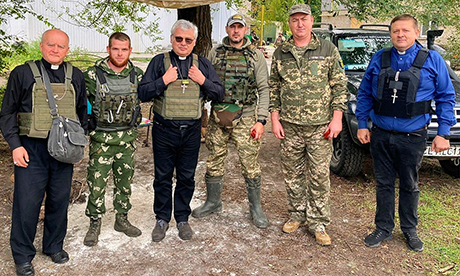Cardinal Konrad Krajewski and those working with him emerged unscathed after they came under fire on Saturday, near the Ukrainian city of Zaporizhzhia.
Krajewski, was sent by Pope Francis to Ukraine to show the pope’s “closeness” to the Ukrainian people.
“It would be good if you could go again to Ukraine, to the war zones, to visit and bring aid to those communities that are still there after almost 200 days of war,” Francis told him during the recent meeting of cardinals in Rome.
Krajewski told the Italian daily, Corriere della Sera, that he had gone into war zones where only soldiers entered.
Describing the task as bringing aid to people trapped in no-man’s-land, Krajewski told Vatican News “No one besides soldiers enters anymore.
“While we managed to give the first portion of humanitarian help peacefully, during the second one they started to fire on us,” said Krajewski.
“For the first time in my life, I didn’t know where to run. Because it is not enough to run, you have to know where to go,” said the Polish-born cardinal.
Krajewski was grateful to a Ukrainian soldier who guided the group to shelter and warned that they had 10 minutes before the second round of attacks would start.
“They say there are a lot of traitors in that terrain,” Krajewski told Crux, referring to people who collaborate with Russian forces.
“When they spot humanitarian help being distributed, they give a location through their mobile phone and the gunfire starts.”
Krajewski said that after taking shelter, everyone was well, adding “We managed to distribute papal rosaries to the soldiers.
“Almost all of the Ukrainian soldiers, no matter what their faith was, put the rosary on their necks immediately.”
On Sunday Krajewski and his team went to visit the site of mass graves left behind by Russian occupiers, declaring “the entire world now knows they’re real”.
So far, officials of Ukraine’s Defence Ministry say that at least 440 unmarked graves have been discovered in the wake of a Russian withdrawal from the eastern city of Izyum, despite repeated denials from Russian officials that their forces have targeted civilians or committed war crimes.
In the past, Moscow has suggested that purported images of civilian casualties or mass graves in conflict zones amount to Ukrainian propaganda.
Krajewski removed any doubt saying the mass graves were located in pine tree forests, and some victims displayed signs of torture, with their hands tied behind their backs.
Sources
Additional readingNews category: Great reads, World.




